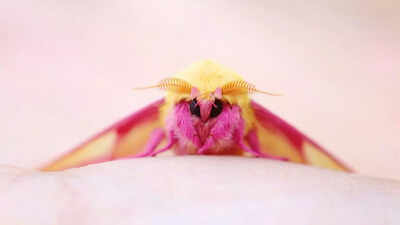ARTICLE AD BOX

For all the editing apps with filters, palettes, and mood boards, we still can’t top nature when it comes to showstoppers. Case in point here is the beautiful rosy maple moth (Dryocampa rubicunda).
A creature so perfectly coloured that you might mistake it for a dessert. At just over an inch wide, the adult rosy maple moth might not be big, but what it lacks in size, it makes up for in charm. Its fuzzy body is bright yellow on top, raspberry pink beneath. Its wings? Blushed at the edges like a scoop of sherbet melting into sunshine. The head, meanwhile, looks like a miniature craft-store pompom. It’s no wonder kids gasp when they see one, and adults reach for their phones.These moths are found across the eastern and northern U.S. and parts of Canada, from Quebec to the Carolinas, often fluttering near porch lights in early summer. They're especially fond of maple trees, hence the name, but have been known to hang out on oaks too.
Why are they so Instagrammable?

There’s something about a creature that looks like it wandered out of a Lisa Frank sketchpad that just begs to be posted. In a world obsessed with curated cuteness, the rosy maple moth is naturally viral.
Color theory in action: That high-contrast combo of warm yellow and cool pink creates visual harmony, the kind that pops on a feed.Texture play: The moth’s woolly body and velvety wings photograph like plush toys. Even macro shots feel cozy.Surprise factor: Moths aren’t typically the stars of aesthetic content. Butterflies get the glory. But the unexpected beauty of this moth sparks joy and fascination.You don’t need a DSLR or a ring light.
Just a maple tree, a humid summer night, and a bit of luck.
Behind the fluff: Nature’s little trickster
Of course, the story doesn’t end pretty. These moths have a whole life cycle that’s... less cute.

Before becoming a fuzzy icon, they start as yellow eggs, laid in small clusters on the underside of leaves. Within two weeks, they hatch into green-striped mapleworms. These pale green caterpillars, striped and spiked, look like tiny punk rockers. They devour maple leaves with gusto, chewing from the edge toward the center in neat little arcs.
Aesthetically? Not so photogenic. Environmentally? A nuisance, sure, but rarely a real threat.After a month of leaf feasting and several molting stages (called instars), the now-thicker, darker caterpillars head underground. They dig shallow chambers beneath their host tree, settle into pupae, and wait out the winter in earth-insulated cocoons. When the weather warms, they emerge in all their pink-yellow glory.Adults don’t feed; they exist to mate, lay eggs, and dazzle. And just like that, the cycle spins again. There’s something quietly lovely about a creature that lives most of its life hidden, only to bloom into a tiny pastel masterpiece.



.png)
.png)
.png)
















 3 hours ago
5
3 hours ago
5









 English (US) ·
English (US) ·